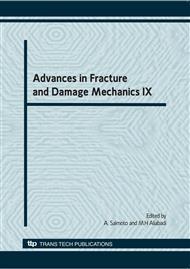p.725
p.729
p.733
p.737
p.741
p.745
p.749
p.753
p.757
Investigation of Surface Crack Types under Axial Compression Loading for a Case-Hardening Steel
Abstract:
During cold-forming operations the formability of the materials can be reached due to the low process temperature, leading to crack initiation. For the investigated case-hardening steel 16MnCrS5 longitudinal cracks and shear cracks are identified as the main crack types. The evolution of both crack types is determined by scanning electron microscope (SEM)-investigations and a simplified finite element method (FEM)-model. The results reveal that the initiation point of shear cracks is located at the surface. In contrast thereto longitudinal cracks emanate from second phase particles in the rim zone.
Info:
Periodical:
Pages:
741-744
Citation:
Online since:
November 2010
Authors:
Keywords:
Price:
Сopyright:
© 2011 Trans Tech Publications Ltd. All Rights Reserved
Share:
Citation:


